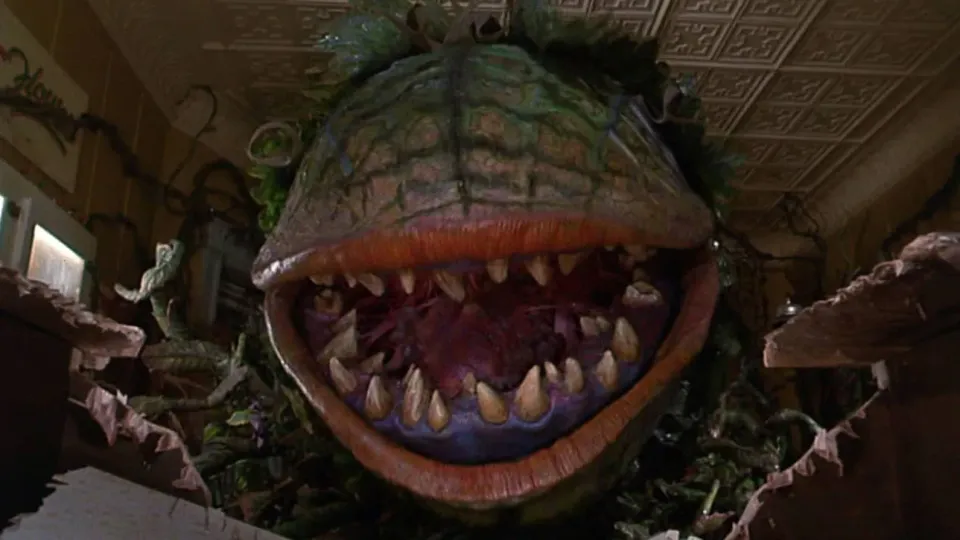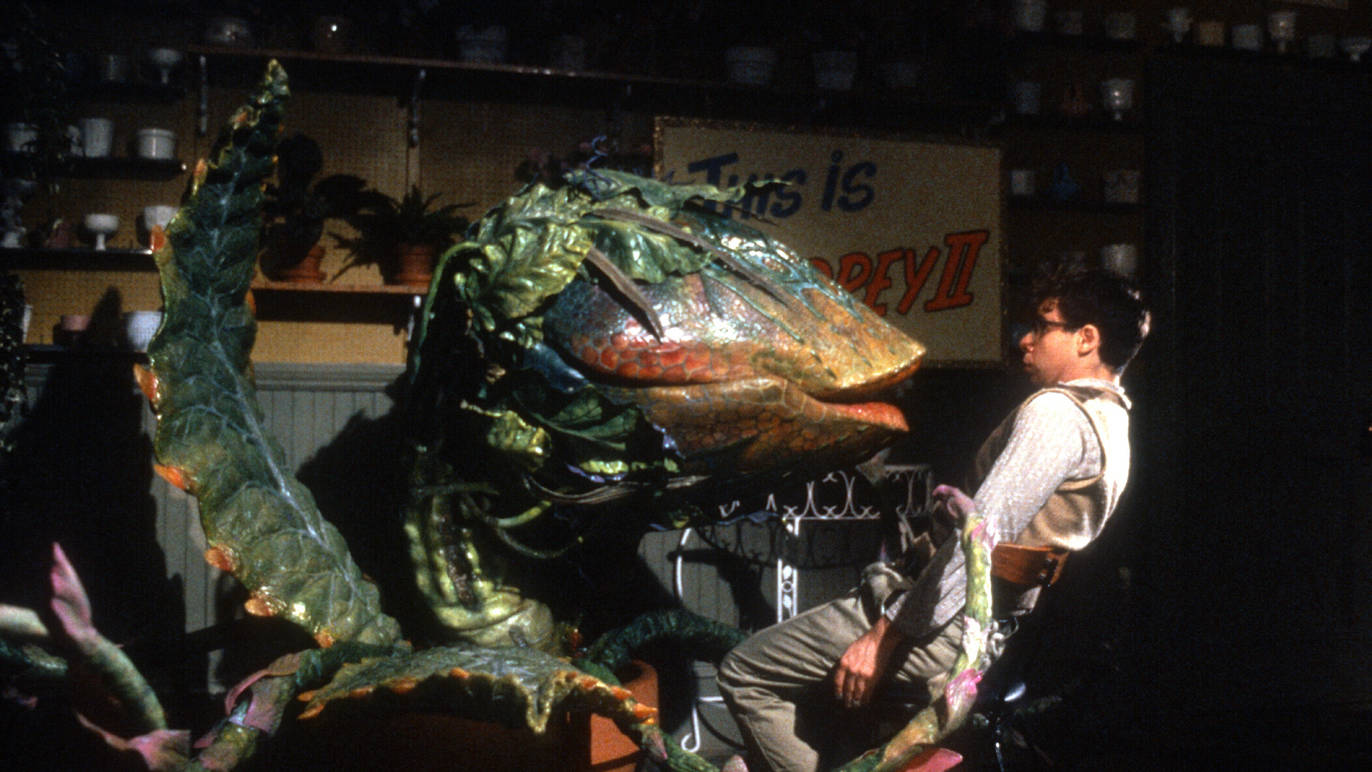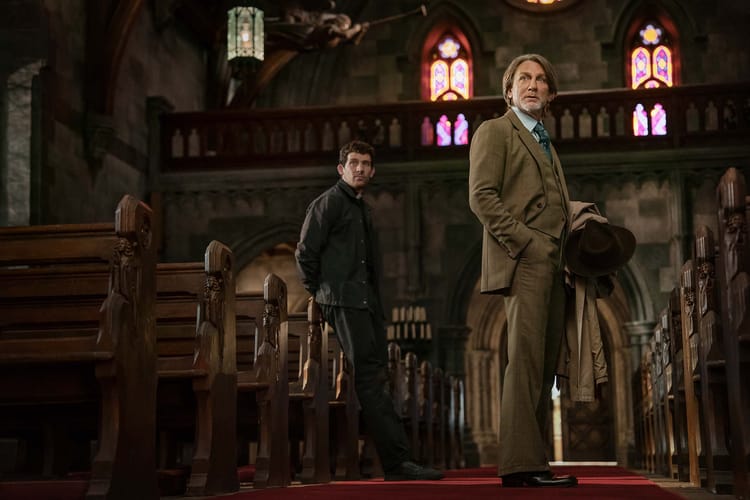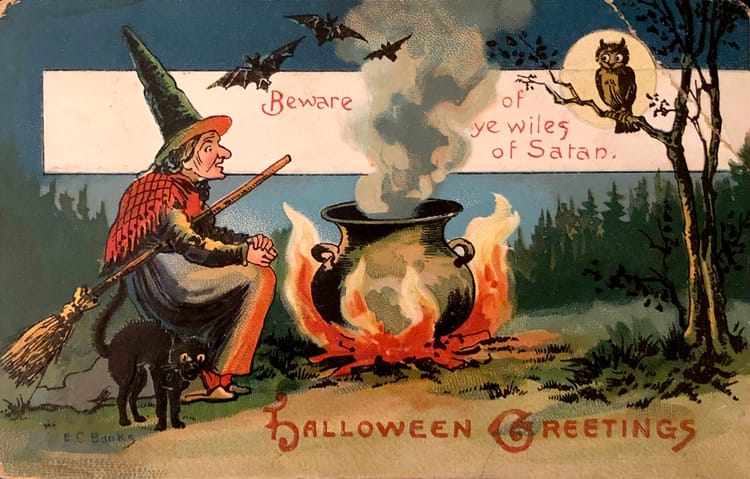Little Shop of Horrors: a movie musical where every frame is worth studying

(Welcome to the Wednesday newsletter! Each week, I’m publishing a new pop culture essay from a freelancer. Remember: Your subscription fee helps me pay these freelancers for their efforts! This week: Drew Gillis celebrates the 35th anniversary of Little Shop of Horrors' movie version.)
At the turn of the millennium, my family would take weekly visits to our suburban New Hampshire public library to peruse the VHS section. Sure, our selections varied, but there was one cassette that we seemed to get more often than most, because the whole family — my Sopranos loving father, my musical theatre enthusiast mother, my Star Wars-pilled brother, and I — could always agree on: Little Shop of Horrors.
Based on a 1960 B-movie that Roger Corman shot in five days as a dare, Little Shop of Horrors follows Seymour Krelborn (Rick Moranis), the most adorably pathetic flower shop employee you ever did see. Seymour is a poor orphan who dreams of leaving Skid Row as he pines after his coworker, Audrey (Ellen Greene). Audrey pines after him, too, but they both lack confidence and self-determination. Though they both want more, they are effectively trapped on Skid Row — Seymour by what amounts to indentured servitude, Audrey by an abusive relationship with a sadistic dentist.
Then, divine intervention: Aliens leave a strange and unusual plant, a sort of cabbage with lips, in the wholesale flower district. Seymour names the plant Audrey II and brings it into the flower shop, which, thanks to Audrey II, becomes busier than ever. Seymour becomes a minor celebrity, and finally starts to capture the attention of Audrey. The high is cut short when Audrey II starts talking and demanding human flesh. Seymour acquiesces, unwittingly aiding Audrey II on its quest for world domination.
Oh, and this whole story is a musical.
Seymour’s tale is ultimately cautionary in the way of classic, pre-Disneyfied fairy tales. There is plenty of magic and whimsy, sure, but there are also no punches pulled (and, depending on which cut of the film you watch, no happy ending). As Bill Hader’s Stefon would say, this movie has everything: a ‘60s girl group Greek Chorus, high drama and low comedy, a sly critique of consumer capitalism, Bill Murray and Steve Martin role-playing BDSM-as-dental-cleaning, banger musical number after banger musical number, a send-up of sci-fi B-movies, a performance that lifted Ellen Greene from theatre-cult fame to regular cult fame, and more.
The movie is likely directly responsible not only for what has turned into my lifelong obsession with musical theatre, but my year working as a florist and my attraction to men who look like Rick Moranis. Nostalgia-fueled biases aside, though, what Little Shop of Horrors manages to pull off in its 100-odd minute runtime is remarkable. With the movie’s 35th anniversary on the horizon and a potential remake being batted around (though not yet confirmed), Little Shop demands to be studied.
A tonal mishmash that avoids tonal whiplash

Little Shop is a text that could easily collapse under the weight of itself. Aside from its outrageous plot, the film has to balance disparate tones and moods, shifting between (and often blending) them at rapid speed. It is keenly self-aware but not winking, thankfully avoiding the trope of breaking the fourth wall to acknowledge how ridiculous its circumstances are. Little Shop manages to win over even the harshest musical-theatre skeptics (the people who go “How do they all know the words to the song? Did they go to rehearsal?”) because it so deftly creates a world where truly anything can happen, and its characters accept that world at face value.
The rules of this world are explained to us deftly and immediately. After a 1950s-style sci-fi crawl, the rug is immediately pulled out from under the audience, revealing the galactic background to be nothing more than an inner-city puddle. In this decaying environment, three impeccably dressed young women appear, singing the title song. These women are at once part of the environment and removed from it — they fit the era we’ve been introduced to, but that’s about it. These women function as a Greek Chorus, commenting on the action of the story but not directly participating in it. Until they do.
Mere minutes later, we get to the second song, “Skid Row (Downtown).” This song is also expository, but instead of introducing us to the world at large, it’s pulling double duty, introducing us to the specific locale and our characters’ motivations. The song is triggered when Mr. Mushnik tells Crystal, Chiffon, and Ronette, the three women we just met, now dressed in street clothes, to scram from the stoop of his flower shop. Then, the rest of the world, including two of our leads, start singing with the Greek Chorus, now back in costume, revealing that the Chorus does actually exist in the real world and that our main characters can see them, know them, interact with them, and inhabit the world like them. Movie musicals like Cabaret or Chicago found success by presenting their musical numbers either on an in-universe stage or in a kind of limbo to comment on the action of the real world. Little Shop’s approach is entirely different: It blurs the line between fantasy and reality until it ceases to exist altogether.
But while Little Shop dissolves boundaries between fantasy and reality, between sci-fi, musical theatre, comedy, and B-movies, it is deliberate and careful about the boundaries it maintains. A good portion of this success can be attributed to the genius of the late Howard Ashman, who wrote the book and lyrics for the musical (he also directed the original stage show, but tapped Frank Oz to helm the film). One of his keys to success was letting his text do the heavy lifting while warning his actors of the “great and potentially fatal mistake” of “play[ing] it for camp.” When the musical’s script was printed for actors in 1985, Ashman wrote in the introduction: “The script keeps its tongue firmly in cheek, so the actors should not… The show’s individual ‘style’ will evolve naturally from the words themselves and an approach to acting and singing them that is almost child-like in its sincerity and intensity.”
Sincerity is the key word here. In a world that is so obviously madcap and insane, the characters react to it naturally. We can relate to these characters; they have understandable human urges, and they’re not shy about expressing them. Seymour dreams about making enough money to leave Skid Row. Audrey wants out of her abusive relationship and to have a house in the suburbs. The most touching moment in the entire film is when she sings “Somewhere That’s Green,” a proto-“Part Of Your World” that is basically an “Average Life Goals” meme. Ellen Greene delivers the song with glass-eyed sincerity, letting the words and the skill of her voice do the heavy lifting. The song is funny and self-aware and heartbreaking and goosebump-inducing all at the same time. It’s a masterclass in musical theatre songwriting and performance.
How Little Shop of Horrors begat the Disney Renaissance

It’s not surprising that the directors Ron Clements and John Musker saw the skill in Ashman and his collaborator Alan Menken and tapped them to write music for The Little Mermaid and Beauty and the Beast, the two movies that essentially saved the Disney brand in the 1990s. This type of madcap world with sincere characters lends itself extremely well to a cartoon musical about witches and curses and princesses.
The movies of the Disney Renaissance kept the movie-musical genre alive in the ‘90s. Those Disney movies were also a huge part of my childhood, and when I look back at my favorite movies of my childhood, whether they be Disney movies or Star Wars or Little Shop of Horrors, they all had one thing in common: sincerity.
This idea of sincerity — not to be confused with optimism — is something that resonates differently in 2021 than it did when Little Shop hit the big screen 35 years ago. It’s an idea, I think, that is a bit at odds with the irony poisoned timeline I log into each day, where hardly anything is genuinely shocking and projecting a blasé aura isn’t so much an attempt to be cool as it is a self-defense mechanism from an increasingly chaotic and gloomy world. It can feel downright foolish to be optimistic in a world ravaged by a pandemic, climate change, or a dysfunctional political system, but it’s incredibly important to be sincere.
The problems in our world make it appealing to check out from it altogether. Little Shop doesn’t exist in that world; it exists where people have emotions that are too big to be talked about, emotions that demand to be sung and belted and danced. It kind of makes sense that the powers that be saw an opportunity for a remake but it would be completely unnecessary because the Little Shop we already have is as close to perfection as it can get.
Little Shop of Horrors presents us with a messed-up world, but it doesn’t look away from it. Its characters have the courage to join the people singing in the street, to be scared, to talk back when a plant starts talking. It is a world that is willing to joke but is unwilling to be a joke. It is chaotic and gloomy and self-aware and occasionally gross. And it is completely genuine.
Episodes is published three times per week and edited by me, Emily VanDerWerff. Mondays feature my thoughts on assorted topics. Wednesdays offer pop culture thoughts from freelance writers. Fridays are TV recaps written by myself. The Wednesday and Friday editions are only available to subscribers. Suggest topics for future installments via email or on Twitter. Read more of my work at Vox.





Member discussion